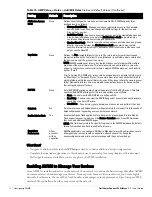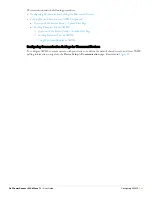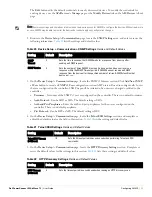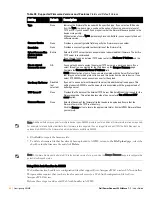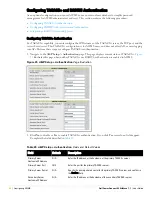
Dell PowerConnect W AirWave 7.1
| User Guide
Configuring AWMS |
47
Defining AWMS Network Settings
The next step in configuring AWMS is to confirm the AMP network settings. Define these settings by navigating
to the
AMP
Setup > Network
page.
Figure 19
illustrates the contents of this page.
Figure 19
AMP
Setup > Network Page
Illustration
Perform the following steps to define the AWMS network settings:
1. Locate the
Primary
and
Secondary Network Interface
sections. The information in these sections should
match what you defined during initial network configuration and should not require changes.
Table 16
describes the settings and default values.
2. On the
AMP
Setup > Network
page, locate the
Network Time Protocol (NTP)
section. The Network Time
Protocol is used to synchronize the time between AWMS and your network reference NTP server. NTP servers
synchronize with external reference time sources, such as satellites, radios, or modems.
To disable NTP services, clear both the
Primary
and
Secondary
NTP server fields. Any problem related to
communication between AWMS and the NTP servers creates an entry in the event log.
Table 17
describes the settings and default values in more detail.
Table 16
Primary and Secondary Network Interface
Fields and Default Values
Setting
Default Description
IP Address
None
Sets the IP address of the AWMS network interface.
This address must be static IP address.
Hostname
None
Sets the DNS name assigned to the AWMS server.
Subnet Mask
None
Sets the subnet mask for the AWMS primary network interface.
Gateway
None
Sets the default gateway for the AWMS network interface.
Primary DNS IP
None
Sets the primary DNS IP address for the AWMS network interface.
Secondary DNS IP
None
Sets the secondary DNS IP address for the AWMS network interface.
Secondary Network
Interface
No
Select Yes to enable a secondary network interface. You must also define the IP
address and subnet mask.
Note: Specifying NTP servers is optional. NTP servers synchronize the time on the AWMS server, not on individual access points.
Secondary network interface options may include multiple telnet terminal configurations, DHCP/BOOTP auto-configuration, time
zone offsets, daylight savings time, and NTP addressing modes such as unicast, broadcast, and multicast. Secondary NTP
information is only supported on AWMS that have multiple interfaces.
Summary of Contents for PowerConnect W Airwave 7.1
Page 1: ...Dell PowerConnect W AirWave Version 7 1 User Guide ...
Page 10: ...10 Dell PowerConnect W AirWave 7 1 User Guide ...
Page 30: ...30 Installing AWMS Dell PowerConnect W AirWave 7 1 User Guide ...
Page 194: ...194 Creating and Using Templates Dell PowerConnect W AirWave 7 1 User Guide ...
Page 260: ...260 Performing Daily Administration in AWMS Dell PowerConnect W AirWave 7 1 User Guide ...
Page 294: ...294 Creating Running and Emailing Reports Dell PowerConnect W AirWave 7 1 User Guide ...
Page 302: ...302 Using the AWMS Helpdesk Dell PowerConnect W AirWave 7 1 User Guide ...
Page 304: ...304 Package Management for AWMS Dell PowerConnect W AirWave 7 1 User Guide ...
Page 308: ...308 Third Party Security Integration for AWMS Dell PowerConnect W AirWave 7 1 User Guide ...
Page 314: ...314 Access Point Notes Dell PowerConnect W AirWave 7 1 User Guide ...
Page 316: ...316 Initiating a Support Connection Dell PowerConnect W AirWave 7 1 User Guide ...
Page 318: ...318 Cisco Clean Access Integration Perfigo Dell PowerConnect W AirWave 7 1 User Guide ...
Page 330: ...330 Third Party Copyright Information Dell PowerConnect W AirWave 7 1 User Guide ...
Page 334: ...334 Index Dell PowerConnect W AirWave 7 1 User Guide ...




















